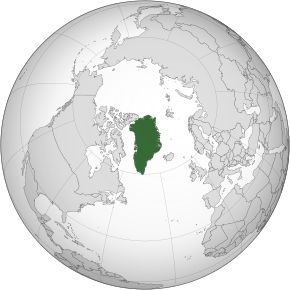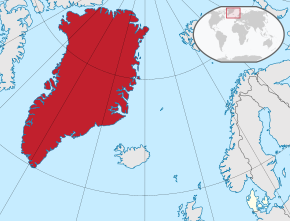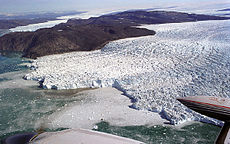Greenland
Greenland | |
|---|---|
| Anthem: "Nunarput utoqqarsuanngoravit" (Greenlandic) (English: "You Our Ancient Land") | |
| Kalaallit anthem: "Nuna asiilasooq" (Greenlandic) (English: "The Land of Great Length")[a] | |
 Location of Greenland | |
 Location of Greenland (red) in the Kingdom of Denmark (red and beige) | |
| Sovereign state | Kingdom of Denmark |
| Union with Norway | 1262 |
| Danish-Norwegian recolonization | 1721 |
| Cession to Denmark | 14 January 1814 |
| Home rule | 1 May 1979 |
| Further autonomy and self rule | 21 June 2009[2][3] |
| Capital and largest city | Nuuk 64°10′N 51°44′W / 64.167°N 51.733°W |
| Official languages | Greenlandic[b] |
| Recognised languages | Danish, English and other languages if necessary[b] |
| Ethnic groups (2018) | |
| Religion | Christianity (Church of Greenland) |
| Demonym(s) |
|
| Government | Devolved government within a parliamentary constitutional monarchy |
• Monarch | Frederik X |
| Julie Præst Wilche | |
• Premier | Múte Bourup Egede |
| Mimi Karlsen | |
| Legislature | Inatsisartut |
| National representation | |
| 2 members | |
| Area | |
• Total | 2,166,086 km2 (836,330 sq mi) |
• Water (%) | 83.1[c] |
| Highest elevation | 3,700 m (12,100 ft) |
| Population | |
• 2020 estimate | 56,081[6] (210th) |
• Density | 0.028/km2 (0.1/sq mi) |
| GDP (PPP) | 2011 estimate |
• Total | $1.8 billion[7] (not ranked) |
• Per capita | $37,000 (40-th) |
| HDI (2010) | high · 61st |
| Currency | Danish krone (DKK) |
| Time zone | UTC±00:00 to UTC-04:00 |
| Date format | dd-mm-yyyy |
| Driving side | right |
| Calling code | +299 |
| Postal codes | 39xx |
| ISO 3166 code | GL |
| Internet TLD | .gl |



Greenland is the world's largest island.[9][10][11][12][13] Greenland is a self-governing territory of the kingdom of Denmark. This large Arctic island is near two countries, Iceland to the east and Canada to the west. The island is geographically part of North America but the culture is more closely related to Denmark.[14] It has a population of only 50,000 people, limited by its cold climate. Most of the civilian population lives in the southern part of the island, on the coasts. [source?] The capital of Greenland is Nuuk.
The island is democratic, with its own elections and a representative seat of government in Nuuk. It is part of the Kingdom of Denmark, a constitutional monarchy with Queen Margrethe II as head of state. Greenland has two members in Denmark's Folketing.
The island's Thule Air Base is under Danish control, but is administered by the United States Air Force.[15]
The island is the least densely populated country in the world, with a density of 0.026 people per square kilometer.[16][17][18] Antarctica is not counted because it is not an independent country and has no permanent inhabitants. The ice sheet that covers Greenland may hide three separate islands, which have been joined by glaciers since the last geologic ice age.[19][20][21][22]
In Greenland, there are no forests. In the south, at the coastal area, only some dwarf trees are found.[23]
History
[change | change source]Greenland has been inhabited at intervals over at least the last 4,500 years by Arctic peoples. They came from what is now Canada.[24][25] Norsemen settled the uninhabited southern part of Greenland beginning in the 10th century, having previously settled Iceland.
Norsemen would later set sail from Greenland and Iceland with Leif Erikson. They were the first known Europeans to reach North America. They did so nearly 500 years before Columbus reached the Caribbean islands. Inuit peoples arrived in Greenland in the 13th century. Though under continuous influence of Norway and Norwegians, Greenland was not formally under the Norwegian crown until 1261. Their colonies declined after the Black Death in the late 1400s. Denmark–Norway, joined in alliance at the time, reclaimed sovereignty over the island in the 17th century. Greenland became Danish in 1814.[26]
Languages
[change | change source]The island is populated mostly by Inuit and Scandinavians who speak Greenlandic, an Eskimo-Aleut language. Danish is also spoken by most people. The national anthem of Greenland is Nunarput utoqqarsuanngoravit. Greenlandic became the sole official language in June 2009.[27] However, it is the dialect of western Greenland, leaving other dialects to become less used and endangered. Danish is used in practice by professional people and by many of the Inuit population. English is taught in schools from the first year onwards.[28]
Administrative divisions
[change | change source]
Until 2009, there were 20 communes in Greenland. Unless stated otherwise, they are in the district Kitaa:
- Nanortalik
- Qaqortoq
- Narsaq
- Ivittuut
- Paamiut
- Nuuk
- Maniitsoq
- Sisimiut
- Kangaatsiaq
- Aasiaat
- Qasigiannguit
- Ilulissat
- Qeqertarsuaq
- Uummannaq
- Upernavik
- Ammassalik (District Tunu)
- Ittoqqortoormiit (District Tunu)
- Qaanaaq (District Avannaa).
This changed on January 1st, 2009, when these were merged into four large communes:
- Kommune Kujalleq (7.755 inhabitants)
- Qaasuitsup Kommunia (17.867)
- Qeqqata Kommunia (9.627) und
- Kommuneqarfik Sermersooq (20.998).
In addition, some parts of Greenland are outside a commune, namely:
As of January 1st, 2008, 218 people lived there.[29]
Landscape
[change | change source]The island has many mountains. Gunnbjorn Fjeld is the tallest mountain Greenland.[30] All of the cities are on the coast, because everywhere else is covered by a big layer of ice.[31] The major cities are Nuuk, Sisimiut, Ilulissat, and Qaqortoq.
Climate
[change | change source]The coasts of Greenland are tundras. Away from the coast, it is considered an ice cap. Summers in Greenland are short and cool while winters are long.
Related pages
[change | change source]Notes
[change | change source]- ↑ Nuna asiilasooq has equal status as a regional anthem but is generally used only on the self-government of Greenland.[1]
- ↑ 2.0 2.1 Greenlandic has been the sole official language of Greenland since 2009.[2][4]
- ↑ As of 2000: 410,449 km2 (158,475 sq mi) ice-free; 1,755,637 km2 (677,855 sq mi) ice-covered.
Density: 0.14/km2 (0.36 /sq. mi) for ice-free areas.
References
[change | change source]- ↑ "03EM/01.25.01-50 Spørgsmål til Landsstyret: Hvornår fremsætter Landsstyret beslutning om Grønlands" [03EM/01.25.01-50 Questions to the Home Rule Government: When does the Home Rule Government make a decision on Greenland]. Government of Greenland. 7 October 2003. Archived from the original on 13 December 2014. Retrieved 13 December 2014.
- ↑ 2.0 2.1 (in Danish) TV 2 Nyhederne – "Grønland går over til selvstyre" Archived 2023-08-09 at the Wayback Machine TV 2 Nyhederne (TV 2 News) – Ved overgangen til selvstyre, er grønlandsk nu det officielle sprog. Retrieved 22 January 2012.
- ↑ "Self-rule introduced in Greenland". BBC News. 21 June 2009. Archived from the original on 25 April 2010. Retrieved 4 May 2010.
- ↑ (in Danish) Law of Greenlandic Selfrule Archived 8 February 2012 at the Wayback Machine (see chapter 7)
- ↑ "Greenland". CIA World Factbook. Retrieved 15 May 2007.
- ↑ "Population and Population Growth 1901-2020". Statistical Greenland. Archived from the original on 13 November 2022. Retrieved 7 April 2020.
- ↑ Greenland in Figures 2013 (PDF). Statistics Greenland. ISBN 978-87-986787-7-9. ISSN 1602-5709. Archived from the original (PDF) on 21 September 2013. Retrieved 2 September 2013.
{{cite book}}:|journal=ignored (help) - ↑ Avakov, Aleksandr Vladimirovich (2012). Quality of Life, Balance of Powers, and Nuclear Weapons (2012): A Statistical Yearbook for Statesmen and Citizens. Algora Publishing. p. 51. ISBN 978-0-87586-892-9.
- ↑ "Greenland from Continuum Encyclopedia of Popular Music of the World: Locations". credoreference.com. 2011. Retrieved 29 August 2011.
- ↑ "Greenland from McGraw-Hill Concise Encyclopedia of Science and Technology". credoreference.com. 2011. Retrieved 29 August 2011.
- ↑ "Greenland from The Houghton Mifflin Dictionary of Geography". credoreference.com. 2011. Retrieved 29 August 2011.
- ↑ Joshua Calder's World Island Info
- ↑ "CIA World Factbook". Archived from the original on 2020-05-09. Retrieved 2011-02-06.
- ↑ "Facts about Greenland | Nordic cooperation". www.norden.org. Retrieved 2023-07-07.
- ↑ "Qaasuitsup kommunia". www.qaasuitsup.gl. Archived from the original on 21 July 2011. Retrieved 11 February 2018.
- ↑ "The 2008 Revision Population Database". Esa.un.org. 2009-03-11. Archived from the original on 2007-03-21. Retrieved 2010-09-06.
- ↑ Department of Economic and Social Affairs Population Division (2009). "World Population Prospects, Table A.1" (PDF). 2008 revision. United Nations. Archived from the original (PDF) on 2009-03-18. Retrieved 2009-03-12.
{{cite journal}}: Cite journal requires|journal=(help) - ↑ World POPClock Projection at 18:42, 28 October 2008 (UTC)
- ↑ New York Times The Warming of Greenland
- ↑ Ellensburg Daily Record (Google News) Greenland Icecap bridges three islands
- ↑ Los Angeles Times "Greenland's Ice Sheet is slip-sliding away"
- ↑ From the map of the bedrock: if, as the ice melted, the sea rose 50 metres, then Greenland would definitely be three islands.
- ↑ "Greenland - Credo Reference Topic". credoreference.com. 2011. Retrieved 29 August 2011.
- ↑ "Saqqaq-kulturen kronologi". National Museum of Denmark. Archived from the original on 7 December 2013. Retrieved 2 August 2013.
- ↑ Saillard J, Forster P, Lynnerup N, Bandelt HJ, Nørby S (2000). "mtDNA variation among Greenland Eskimos: the edge of the Beringian expansion". American Journal of Human Genetics. 67 (3): 718–26. doi:10.1086/303038. ISSN 0002-9297. PMC 1287530. PMID 10924403.
- ↑ Sowa F. 2014. Greenland. In: Hund A. Antarctica and the Arctic Circle: a geographic encyclopedia of the Earth's polar regions. Santa Barbara, California: ABC-CLIO, pp. 312–316.
- ↑ "Danish doubts over Greenland vote". BBC News. 27 November 2008. Archived from the original on 7 December 2012. Retrieved 10 February 2013.
- ↑ "Travelling in Greenland". Greenland Representation to the EU, Greenland Home Rule Government. Archived from the original on 16 May 2014.
- ↑ "KANUKOKA". Archived from the original on 2008-09-24. Retrieved 2011-08-29.
- ↑ "Greenland Maps & Facts". WorldAtlas. 2021-02-25. Retrieved 2023-07-07.
- ↑ Barringer, Felicity. "Scientists Want Publisher to Refreeze Greenland," New York Times. September 24, 2011.
Other websites
[change | change source]- "Greenland". The World Factbook (2024 ed.). Central Intelligence Agency.
- Greenland Homerule Archived 2006-09-07 at the Wayback Machine - Official site
- Images of Greenland[permanent dead link]

